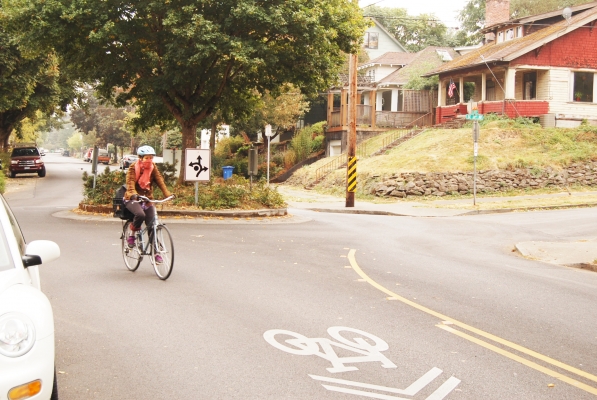Better bikeways associated with higher home values

Proponents of advanced bikeways will point out a growing body of research on these facilities’ safety and benefits for cycling. They can now add another benefit: higher home values.
Research led by Jenny Liu of Portland State University looked at property around advanced bikeways in Portland, defined as bicycle boulevards, protected bike lanes and buffered bike lanes. She found positive effects on property values close to one of these bikeways and an even stronger effect where the network was denser.
Liu presents her research Wednesday at the annual meeting of the Transportation Research Board in Washington, D.C. Learn more or download the research paper.
For single family home sales, being a quarter mile closer to an advanced bikeway translated to a $686 premium, while increasing the density by a quarter mile represented a $4,039 premium. For multi-family homes, the effect of being close to a bikeway wasn’t statistically significant on sale price, but increasing the density of bikeways translated to $4,712 of value.
The research can inform policymakers who may question how much residents value bikeways and provide insight into siting decisions. “My results don’t necessarily say to put one here or not, but it does show there is indeed a preference for homeowners and residents to have these bike lanes near them,” Liu said.
“And it’s not just about being close to a bike lane but having that dense network.”
Liu included the density measure—counting total length of these bikeways within a half-mile buffer around a home—after taking inspiration from researchers who studied housing near parks and open space. “They found it was not only how far it was from you, but how much open space you have within a certain distance of you.”
To show how the research might help policymakers, Liu applied her findings to the proposed Green Loop, a 6-mile linear park and active transportation facility through central Portland. She found this new bikeway would increase single-family and multifamily property values.
Interestingly, the proposal would not bring an advanced bikeway closer to many homes. The increases come, Liu found, from making the bikeway network denser.
The research applies to bikeways in the Portland context, Liu said. More research could determine whether the findings hold for other urban areas.
It also groups the different types of advanced bikeways together. Bike boulevards make up most of Portland’s advanced bikeway network, but those facilities may show different effects than, say, protected bike lanes, upon closer inspection.
Liu is working on follow-up research to break out the facility types and has several related projects in the works. Still, she believes there’s plenty in this paper for practitioners and policymakers to consider.
“This would be useful for bike planners in any of the cities around the world thinking of investing more in bike facilities and want to get their hands on solid, quantitative evidence on what is people’s preference for bike facilities,” she said.
- Read more of our TRB coverage
- Learn more about Liu’s research
This research stems from the Portland Climate Action Collaborative, a research partnership between Portland State’s Institute for Sustainable Solutions and the Portland Bureau of Planning and Sustainability. The TRB paper is No. 17-02259, presented at 10:15 a.m. Wednesday, Jan. 11 in Hall E of the convention center, site H324.
